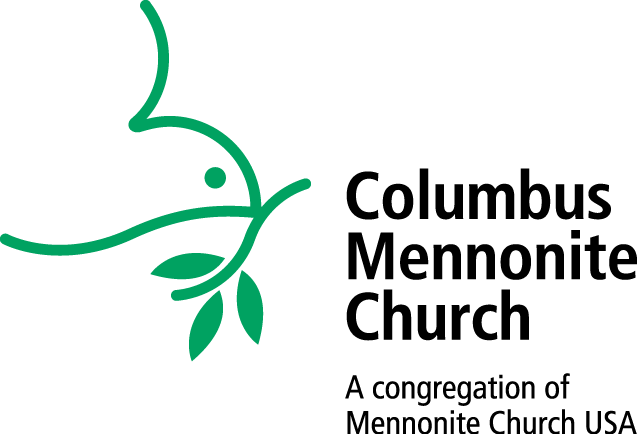In the world, there is a parable | July 23
Twelve Hymns Project: HWB 614 In the bulb there is a flower
Text: Matthew 6:25-29
Three times a year Mennonite Central Committee publishes its Washington Memo. It’s a little six page pamphlet. Each one focuses on a key social or political area of concern, giving historical background, policy principles for addressing the situation, ways MCC is involved, and ways for the reader to pray and act for peace. We get it in the church office.
The spring/summer 2017 issue is about US/North Korea relations. The cover page includes a large picture of an agricultural field with mountains in the background. On the ground and in the air are a number of birds, cranes. With MCC’s permission, we’ve used that image for today’s bulletin cover.
The cover page of the Washington Memo includes a caption beside this picture that says this: “View from South Korea into North Korea. Red crowned cranes are an important symbol on both sides of the border of longevity, purity and peace. The cranes thrive in the demilitarized zone (DMZ) between the countries because of the relatively undisturbed habitat.”
Seeing this, I felt myself drawn into something resembling a parable of Jesus. Out of curiosity I did some online research on these cranes and their place in the Korean peninsula.
It turns out the Smithsonian Magazine did an article on red-crowned cranes back in April of 2011. It’s title and opening line is this: “The DMZ’s thriving resident: The Crane. Rare cranes have flourished in the world’s unlikeliest of sanctuary, the heavily mined demilitarized zone between North and South Korea.”
It turns out…this is a complex parable. More on that in a bit.
Parable was a favorite form of teaching for Jesus. Parables frequently, but not always, reference the natural world and invite the hearers to consider the wisdom on display. Parables…
Be thou my vision | July 16
Twelve Hymns Project: Be thou my vision, HWB 545
Text: Isaiah 6:1-8
“Be thou my vision” is a prayer. It’s an ancient prayer. The language feels old. When’s the last time you were having a conversation and found yourself saying “naught be all else to me save that thou art?” I haven’t decided yet whether I know what that means. But we sing it. One of the wonders of setting our prayers to music is that we say things, we sing things, without having to understand everything we’re singing. Sometimes the music and the rhythm of the words are enough to make it a prayer.
The English feels old, but the song is Irish through and through, in text and in melody. What we have is just a translation. The original is old enough that no one’s quite sure how old. It may go as far back as the 6th century, words of an Irish poet, Saint Dallan. Or maybe it was written a couple hundred years after Saint Dallan and just got attributed to him. The oldest surviving manuscripts of this Irish prayer are from the 10th or 11th centuries.
Before Saint Dallan, around the year 401, a young man and his family were walking along a beach in the Western part of Britain. They were interrupted by a fleet of boats, Irish warriors. The warriors demolished the nearby village and captured the young man, taking him back to Ireland and selling him to a local warlord. The young man’s name was Patricius.
Patricius was enslaved as a shepherd, spending his time in the wild with his master’s animals, exposed to the weather and foraging for food just like the animals he kept. He did this for six years. During that time he had an awakening toward the Christian faith he had grown…
Lullabies for a Revolution | July 9, 2017
12 Hymns Project
STS 124: My soul cries out
Scripture texts: 1 Sam. 2:1-10; Luke 1:46-55
The world is about to turn.
I have to admit that on more than one occasion I have slipped up and changed the lyrics to “the world is about to burn,” which was, perhaps, less of a slip up and more of a reflection on the world around us.
The world is about to turn. Things are changing. A new day is dawning, but not just any new day. The air is crisp with possibilities. Breathe it deeply. A reverie of hope tiptoeing toward that vernal awakening; creation unfolding, stretching cramped wings that have caught the scent of a favorable breeze.
The world is about to turn.
Whether turning or burning, the world is making way for something new. God is making way for something new, and our hearts shall sing of this day God brings.
Of our top 12 hymns, My Soul Cries Out, also known as the Canticle of the Turning, is one of the newer ones, first published less than 30 years ago. One of the advantages of this is that I was able to find a blog post about the hymn that was written by the the arranger of the music and author of the text, Rory Cooney.
Cooney writes that the song was written for his parish in Phoenix, Arizona in order to tie together in worship the themes of Luke’s gospel during Lectionary Year C when Luke is a main focus. The more he thought about the monumental task of tying together all of the themes of Luke’s gospel the more he kept coming back to Mary’s song at the end of the first chapter.
Often called the “Magnificat” because of the first word in the latin translation that means “to magnify,” Mary’s song speaks broadly and…
This place | July 2
Twelve Hymns Project: What is this place
Text: 1 Cor 3:16
Every fall we have an Inquirers Sunday school class. It’s open to anyone, but geared for adults new to the congregation. It’s basically an overview of how Mennonites approach Christian faith, plus an introduction to how this congregation does church together.
Most years I use HWB 1, What is this place, as an opening meditation for one of the sessions. I suppose I could make these newcomers sight read it to see if they can handle the harmonies, but it’s a test I myself would fail, and is likely not a seeker friendly approach. We do hope some of these folks stick around. So we look at the words. We read them through, we talk about how they reflect our theology.
“What is this place, where we are meeting, only a house, the earth its floor, walls and a roof, sheltering people, windows for light, an open door. Yet it becomes a body that lives when we are gathered here, and know our God is near.”
The hymn poses a question that it proceeds to answer. What is this place? The response de-emphasizes the role of the building as the church. Followed by an emphasis on what makes the church what it is – people, gathered, who give their attention to the nearness of God.
When Paul wrote to the Corinthians saying “Do you not know that you are God’s temple and that God’s Spirits dwells in you?” all of those “you’s” were plural. All of the depth of meaning packed into the temple, Paul taught, was embodied in the gathered community. The Spirit dwells in our relationships. This place is a meeting house for the church, for you plural.
We’ve been looking at the stories behind the hymns we’ve chosen as our top 12. But the…
All shall be well… | June 18
Twelve Hymns Project: When peace like a river
Text: Job 29:1-5; 30:16-20
In May of 1373 Julian of Norwich was deathly ill. Close enough to death that she was given last rites. No one knows what Julian’s birth name was. She was an anchoress, meaning she had anchored herself, stationed herself, within a small church cell, itself attached to the larger building, like a barnacle on a rock, or a ship. This was common in the late Middle Ages. She had chosen a solitary life of prayer and contemplation, committed to staying in that particular place. It was a tiny world spent mostly inside the anchorhold, food and water handed in through a window. But it held a promise of opening one’s mind and soul to the vast expanse of Divine reality. This is the life Julian had chosen, or the life that had chosen her.
Her cell was attached to the Church of St. Julian, which is where she likely got her name. The church was in Norwich, England. Julian of Norwich.
Along with her physical ailments, Julian had been overwhelmed to despair by sin. It consumed her thoughts. She felt so deeply about this, she wrote there was no harder hell than sin. That sin itself was hell, inflicting its own awful suffering.
She was 30 years old, and deathly ill. While receiving last rites, the priest’s crucifix raised above her, Julian experienced a series of visions lasting several hours. During this time, she felt engulfed in the love of God. Just immersed in love. She saw a vision of Jesus saying to her the words she became most remembered for. Jesus said to Julian, “All shall be well, and all shall be well, and all manner of thing shall be well.”
It was an overpowering mystical experience that stayed with her the…

